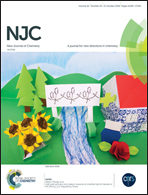Modulating the magnetization dynamics of four phenoxo-O bridged Dy2 complexes based on a Schiff base derived from 8-hydroxyquinoline†
Abstract
Four novel μ-O bridged dinuclear Dy2 clusters have been synthesized successfully by utilizing an 8-hydroxyquinoline (8-HQ) Schiff base ligand and four different co-ligands: [Dy2(bfa)2(L)2(H2O)2]·4CH3OH (1), [Dy2(TTA)2(L)2(H2O)2]·4CH3OH (2), [Dy2(acac)2(L)2(H2O)2]·2H2O (3) and [Dy2(PhCOO)2(L)2(H2O)2] (4) (Hbfa = benzoyl trifluoroacetylacetone, HTTA = thiophene trifluoroacetylacetone, Hacac = acetylacetone, PhCOOH = benzoic acid, H2L = 2-[(4-pyridinebenzoylhydrazone)methyl]-8-hydroxyquinoline). Magnetic studies show that only complex 1 exhibits SMM behavior under a zero dc field with a magnetic relaxation barrier of 68.89 K. When a dc field of 1500 Oe is applied, the value of ΔE/kB increases to 72.63 K. The different dynamic magnetic behaviors of the four Dy2 complexes mainly originate from the tiny changes of the coordination environment and magnetic coupling interaction of the central ions caused by the different co-ligands. Meanwhile, it proves that the co-ligands play an important role in modulating the magnetic properties of Dy-SMMs based on 8-HQ derivatives.



 Please wait while we load your content...
Please wait while we load your content...